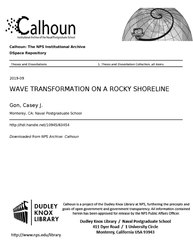File:WAVE TRANSFORMATION ON A ROCKY SHORELINE (IA wavetransformati1094563454).pdf

Original file (1,275 × 1,650 pixels, file size: 1.8 MB, MIME type: application/pdf, 68 pages)
Captions
Captions
Summary[edit]
| WAVE TRANSFORMATION ON A ROCKY SHORELINE
( |
||
|---|---|---|
| Author |
Gon, Casey J. |
|
| Title |
WAVE TRANSFORMATION ON A ROCKY SHORELINE |
|
| Publisher |
Monterey, CA; Naval Postgraduate School |
|
| Description |
Two month-long experiments were performed to evaluate wave transformation across a rough rocky reef at Hopkins Marine Station, Monterey Bay, California. Outside of wave breaking, approximately 30% of the measured wave energy flux by sea and swell waves was dissipated over 140m. The bottom roughness of the rocky reef is defined by the standard deviation of bottom vertical variability (σb) and is 0.9 m. The energy dissipation, 〈εf〉, is related to bottom friction resulting in energy friction factor (fe) found to range between 0.03 and 43.8. An empirical power-law relationship was developed for fe as a function of wave orbital excursion (Ab) and σb. Inside of wave breaking at the shallow-water stations (h<2 m), wave heights, Hrms, collapsed to a non-linear relationship as a function of h that was lower than the estimated wave breaking parameter for this site, γ=0.29. An analytical model for shallow-water wave transformation on a plane sloping bottom with bottom friction only was derived matching the observed results. In deeper stations (h>2m), wave transformation is due to a combination of friction and wave breaking. Field-estimated fe ranged 3.8–8.2. These parameters were applied within the Thornton and Guza wave transformation model from 1983, and tested across the measurement array resulting in skill ≥ 0.9. The wave response to being frictionally dominant has important implications in describing biological communities within a rocky environment. Subjects: wave energy dissipation; bottom friction; rocky reef; wave transformation; wave breaking parameter; gamma |
|
| Language | English | |
| Publication date | September 2019 | |
| Current location |
IA Collections: navalpostgraduateschoollibrary; fedlink |
|
| Accession number |
wavetransformati1094563454 |
|
| Source | ||
| Permission (Reusing this file) |
This publication is a work of the U.S. Government as defined in Title 17, United States Code, Section 101. Copyright protection is not available for this work in the United States. | |
Licensing[edit]
| Public domainPublic domainfalsefalse |
This work is in the public domain in the United States because it is a work prepared by an officer or employee of the United States Government as part of that person’s official duties under the terms of Title 17, Chapter 1, Section 105 of the US Code.
Note: This only applies to original works of the Federal Government and not to the work of any individual U.S. state, territory, commonwealth, county, municipality, or any other subdivision. This template also does not apply to postage stamp designs published by the United States Postal Service since 1978. (See § 313.6(C)(1) of Compendium of U.S. Copyright Office Practices). It also does not apply to certain US coins; see The US Mint Terms of Use.
|
 | |
| This file has been identified as being free of known restrictions under copyright law, including all related and neighboring rights. | ||
https://creativecommons.org/publicdomain/mark/1.0/PDMCreative Commons Public Domain Mark 1.0falsefalse
File history
Click on a date/time to view the file as it appeared at that time.
| Date/Time | Thumbnail | Dimensions | User | Comment | |
|---|---|---|---|---|---|
| current | 23:38, 25 July 2020 |  | 1,275 × 1,650, 68 pages (1.8 MB) | Fæ (talk | contribs) | FEDLINK - United States Federal Collection wavetransformati1094563454 (User talk:Fæ/IA books#Fork8) (batch 1993-2020 #32207) |
You cannot overwrite this file.
File usage on Commons
The following page uses this file:
Metadata
This file contains additional information such as Exif metadata which may have been added by the digital camera, scanner, or software program used to create or digitize it. If the file has been modified from its original state, some details such as the timestamp may not fully reflect those of the original file. The timestamp is only as accurate as the clock in the camera, and it may be completely wrong.
| Short title | WAVE TRANSFORMATION ON A ROCKY SHORELINE |
|---|---|
| Author | Gon, Casey J. |
| Software used | Gon, Casey J. |
| Conversion program | Adobe Acrobat Pro 2017 17.11.30143 |
| Encrypted | no |
| Page size | 612 x 792 pts (letter) |
| Version of PDF format | 1.4 |

